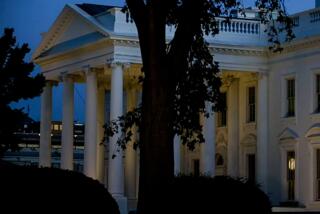State Dept. Asks U.S. Diplomats to Count Computers
- Share via
WASHINGTON — Four months after a laptop computer crammed with top secret arms control data vanished from a State Department office, the department has asked U.S. diplomats around the world to determine if any other classified laptops have disappeared.
All U.S. embassies and consular posts were ordered in a cable to immediately count their portable computers and report back by close of business Friday if any are “determined to be missing or stolen.”
An inventory at State Department headquarters in Washington in recent weeks confirmed that 15 unclassified computers are missing from a total of 1,913. “It’s possible they were stolen,” a spokesman said Friday. “Some could be lost.”
Only one classified computer is missing so far, and department officials still aren’t sure if espionage was involved. Indeed, they recently e-mailed some staff members asking them to check desk drawers, file cabinets, office safes and other possible nooks and crannies to see whether the missing machine was merely misplaced. It didn’t turn up.
The priority cable, which was provided to The Times, was sent on May 11, a full week after Secretary of State Madeleine Albright publicly excoriated her staff and U.S. diplomats overseas and demanded immediate action to stem the security scandals that have rocked the department.
The House Intelligence Committee was even more critical. In a report to Congress, the panel said Wednesday that it was “deeply disturbed” by the State Department’s sluggish response to security lapses, including the missing laptop.
“Were intelligence information not so important for the State Department for the conduct of informed foreign policy, the committee would likely be advocating drastic measures cutting off access to highly classified materials,” said the report, issued as part of the House panel’s proposed intelligence budget for fiscal 2001.
“After all, the unauthorized disclosure of intelligence information jeopardizes lives of intelligence officers and assets and compromises multibillion-dollar secret intelligence capabilities.”
The laptop, which contained thousands of pages of highly classified information, disappeared on Jan. 20 from an allegedly secure work space in the Office of Strategic Proliferation and Military Affairs in the Bureau of Intelligence and Research. The door had been propped open.
The House panel called it “unconscionable” that security “was not a priority” within the department’s intelligence bureau. Albright last month transferred responsibility for protection of highly sensitive information from the intelligence bureau to the Diplomatic Security Bureau.
The CIA formed a task force this month to conduct a risk assessment of the loss of the classified material on the missing laptop’s hard drive.
CIA Director George J. Tenet also agreed to review the State Department’s handling of highly classified code-word material. Specifically, he will recommend how many diplomats really need access to national security secrets and in how many places.
A House staffer said more than 1,000 State Department employees are believed to have top-level security access, and more than 40 rooms are set up so that no one can eavesdrop or get secure information. “That’s an extraordinarily high number of places where that kind of material can be kept.”
In its report, the House panel complained that the State Department failed to notify the FBI of the missing laptop until March 22, more than two months later, crippling the bureau’s ability to conduct a comprehensive investigation.
The panel also criticized the State Department for failing to notify House and Senate oversight committees of the loss of classified materials until the case appeared in the headlines in mid-April.
The report also outlined what it called a “pattern of problems” involving security at the State Department.
In February 1998, an unidentified man in a tweed sport coat walked into the “secure” area of the office of the executive secretary, which is located in Albright’s guarded office suite.
The man was “watched,” the report said, as he picked up and walked out with a sheaf of highly classified documents. He was never identified, and the materials were not recovered.
Last December, a Russian diplomat was arrested outside the State Department as he monitored transmissions from a tiny electronic bugging device hidden in the chair rail of a seventh-floor conference room sometimes used for discussions of classified material.
In separate reports in September 1998 and September 1999, the department’s inspector general also documented a broad failure to protect classified information.
The most recent report noted, for example, that uncleared maintenance, repair and cleaning personnel were “permitted unescorted access to areas where classified intelligence information is handled, processed, stored and discussed.”
More to Read
Sign up for Essential California
The most important California stories and recommendations in your inbox every morning.
You may occasionally receive promotional content from the Los Angeles Times.














